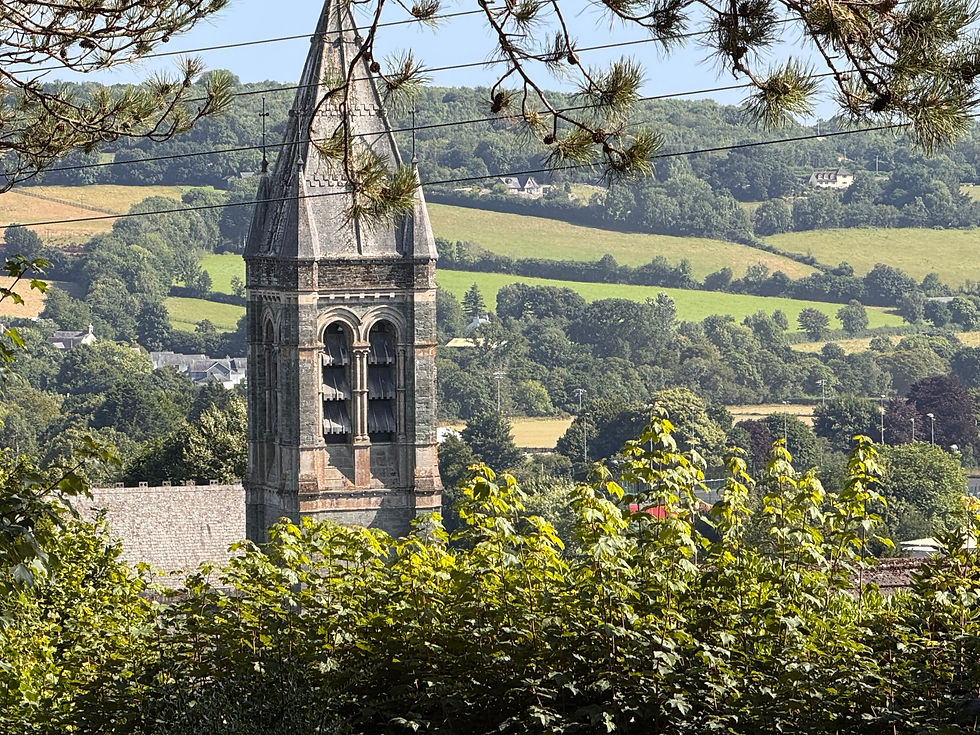Discover the Ancient Stones of Tavistock: A Journey Through Time
- dconn40
- Aug 19
- 4 min read
Updated: Sep 1


Heritage Open Days: An Invitation to Explore
Heritage Open Days provides an exclusive opportunity to get to grips with Tavistock's most ancient monuments - but you need to reserve a space now as they are extremely limited.
A Glimpse into Tavistock's Rich History
In the quiet garden of Tavistock’s vicarage, a trio of granite stones stands watch—weathered, mysterious, and older than almost anything else in the town. These are no ordinary stones; they are some of the earliest Christian memorials in England. They offer a rare glimpse into a time when Celtic traditions, Latin literacy, and early Christianity mingled in the far west of Britain.
These stones—one from the heart of Tavistock and two originally from Buckland Monachorum and Roborough Down—date from the 5th to 7th centuries AD. They form part of a distinctive tradition of early medieval inscribed stones found mostly in regions with strong “Celtic” Christian influence: Ireland, Wales, Cornwall—and here, in Devon. Of the 56 such stones recorded in England, just 12 have been found in Devon, and Tavistock is home to three of them.
The Stone of Nepranus: A Historical Treasure
The most locally significant stone bears the Latin inscription NEPRANI FILI CONBEVI—“(The stone) of Nepranus, son of Conbevus.” Nepranus has a Latinised name, while his father’s name, Conbevus, is Celtic. Measuring 2 metres high and carved from granite, this stone has led a colourful life.
It first came to light in 1780, discovered forming part of the slippery pavement on West Street. Local official Edward Bray had it removed for safety, relocating it as a footbridge over the mill stream near Head Weir. His son, the antiquarian and later vicar Edward Atkyns Bray, was enthralled by its inscription and had it moved to the grounds of Abbey House (now the Bedford Hotel) in 1804. By 1818, after becoming vicar of St Eustachius, Bray placed the stone in his new vicarage garden—where it remains today, lovingly positioned beneath a window and partially cloaked in Irish ivy.
The Buckland Stones: Echoes of a Bygone Era
Flanking Nepranus are two stones originally from Buckland Monachorum parish. The first, inscribed SABINI FILI MACCODECHETI, means “(The stone) of Sabinus, son of Maccodechetus.” Sabinus is another Latin name, while his father’s is Goidelic (early Irish), suggesting a blend of cultural identities. Interestingly, a rectangular slot was later cut into this stone—perhaps to accommodate a gate bolt—hinting at its later, more utilitarian use in a blacksmith’s shop.
The second Buckland stone may be the oldest of the trio. It was discovered by Rev Bray as a gatepost on Roborough Down. Its Latin inscription—DOBUNNI FABRI FILII ENABARRI—translates to “Of Dobunnus the smith, son of Enabarrus.” It is also inscribed with Ogham script, an early medieval Irish alphabet carved vertically along its edge. This makes it especially rare: only a handful of Ogham-inscribed stones are found in Devon.
Rev Bray had long tried to secure the stone, aided in his diplomacy (we are told) by the “beautiful daughter of Sir Anthony Buller,” but the farmer refused. The stone was finally relocated to the vicarage garden in 1868, eleven years after Bray’s death—thanks to the intervention of Hastings Russell, the future 9th Duke of Bedford.
Theories and Interpretations: What Do the Stones Mean?
For years, scholars believed these stones marked the graves of high-status individuals, secular or ecclesiastical. Some may have marked territory or boundary lines. More recently, archaeologist Ken Dark proposed an alternative theory: perhaps these were monuments to saints. In early medieval Britain and Ireland, local saints were frequently commemorated by shrines, and it is possible that these stones once stood in such a context.
Intriguingly, names like “son of Conbevus” may not be familial at all. They might indicate spiritual lineage—Nepranus, for instance, could have been a disciple of the holy man Conbevus, making the stone a marker of religious heritage rather than simple genealogy.
The Importance of Preservation
All three stones are now listed as a Scheduled Ancient Monument by Historic England and noted as “at risk” due to their vulnerability to weathering and vegetation. Tavistock Heritage Trust, in collaboration with Dr Tom Greeves and others, is actively working to secure a more appropriate future for them.
Plans are being made to relocate the Nepranus stone to a protected, public location in Tavistock where its history can be properly interpreted. The Buckland stones are intended to return to their parish, where they will be housed in St Paul’s Church, Yelverton.
Moving the stones is a complex and costly task. Permissions must be obtained from the Secretary of State and the Diocese, and the project will require specialist funding. But it is vital work—these are not just relics, but the earliest surviving voices from Tavistock’s deep past.
Conclusion: A Legacy Worth Protecting
As they stand, nestled beside a quiet lawn in the Vicarage garden, the stones of Nepranus, Sabinus, and Dobunnus bear silent witness to an age when faith, identity, and culture were carved into stone for generations to see. Their preservation is not merely an act of conservation; it is a commitment to honouring the rich tapestry of history that defines Tavistock.
In a world that often overlooks the past, these stones remind us of the importance of understanding our heritage. They invite us to reflect on the lives that once were and the stories that continue to shape our present.





Comments